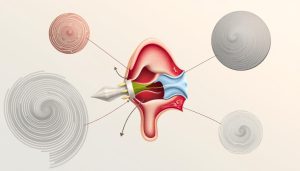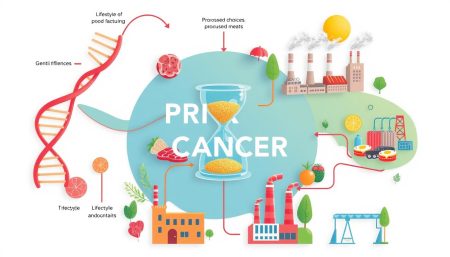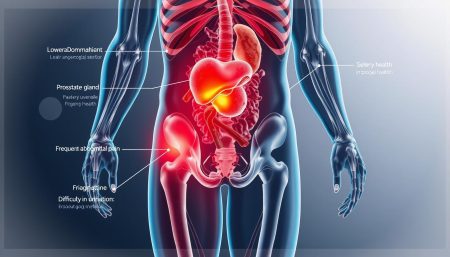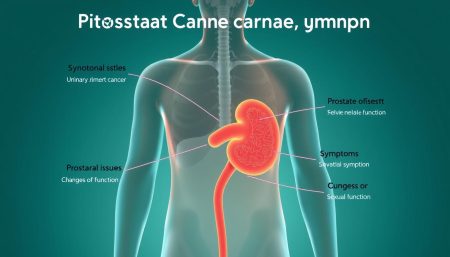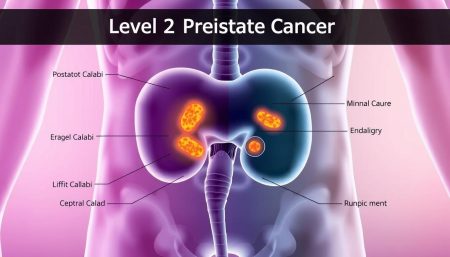CAR T cell therapy has changed cancer treatment, giving new hope to patients. It uses a patient’s immune system to fight cancer. But making CAR T cells is complex, needing special facilities and experts. The process starts with collecting T cells from the patient. It goes through many steps to make the CAR T cell product. Every step is watched closely to ensure it’s safe and works well.
Facilities must follow strict rules and check their work carefully. This guide explores CAR T cell production in detail. It covers facility design, equipment, quality checks, and managing supplies. Knowing how to make CAR T cells better can help more patients get this life-saving treatment.
Introduction to CAR T Cell Therapy Manufacturing
CAR T cell therapies have changed how we treat cancer, giving hope to many. They use a patient’s immune cells to fight cancer. But making these therapies is complex and needs a lot of knowledge.
The process of making CAR T cells involves many important steps. Each step must be done carefully and meet high standards. From collecting T cells to freezing the final product, every detail matters.
Genetically modifying T cells is a key part of making CAR T cells. This step adds a special gene that helps the cells find and attack cancer. The choice of gene, how it’s added, and the design of the gene are all very important.
“The manufacturing process overview for CAR T cell therapies is a testament to the incredible advancements in cell therapy production and the dedication of researchers and manufacturers to bring these life-saving treatments to patients in need.”
Another important step is growing the modified T cells enough for treatment. This requires the right environment, nutrients, and growth factors. It’s all about making sure the cells grow well and stay healthy.
| Manufacturing Step | Key Considerations |
|---|---|
| Leukapheresis | Patient selection, collection protocol, cell viability |
| Genetic Modification | Vector choice, transfection method, CAR design |
| Cell Expansion | Culture conditions, growth factors, nutrient composition |
| Final Formulation | Cryopreservation, quality control, release testing |
Throughout the process, quality control is very important. It ensures the CAR T cells are safe and work well. This includes in-process testing, release testing, and detailed records to follow rules and protect patients.
Overview of the CAR T Cell Manufacturing Process
The CAR T cell therapy making process is very detailed and needs a lot of skill. It starts with getting cells from the patient and ends with making the T cells ready for use. Each step is important for the therapy to work well.
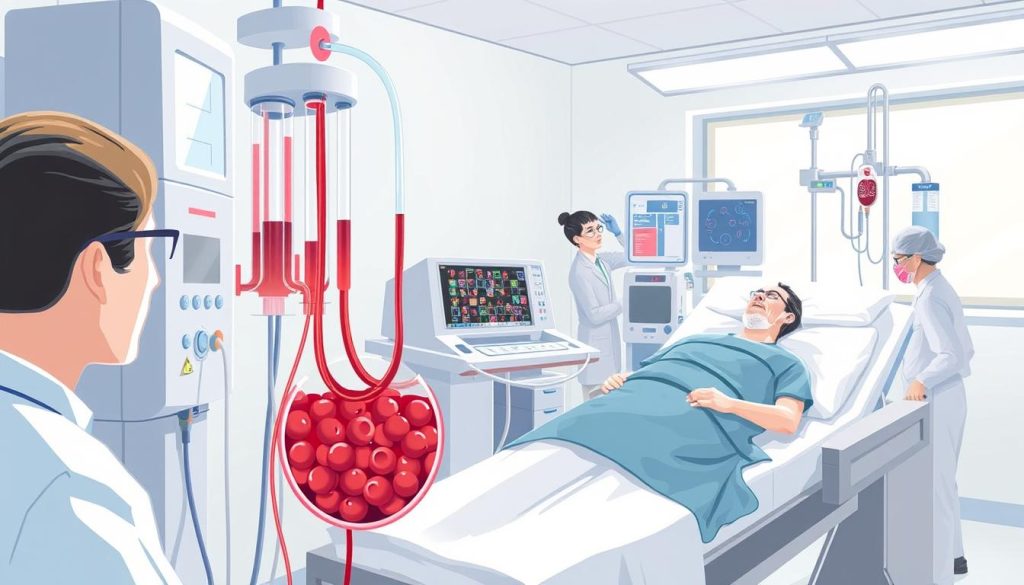
Leukapheresis and Cell Collection
The first step is leukapheresis. It collects white blood cells, like T cells, from the patient’s blood. A special machine separates these cells from the blood, which is then given back to the patient.
T Cell Activation and Genetic Modification
After collecting the T cells, they are made ready for genetic changes. Antibodies and growth factors are used to activate them. Then, a virus with the CAR gene is added to the T cells. This lets them find and attack cancer cells.
| Viral Vector | Advantages | Disadvantages |
|---|---|---|
| Lentivirus | High transduction efficiency Stable gene expression | Potential for insertional mutagenesis |
| Retrovirus | Well-characterized Stable gene expression | Lower transduction efficiency Requires dividing cells |
Cell Expansion and Final Formulation
After the genetic changes, the T cells grow in number. This growth is carefully watched to keep the cells working well. When there are enough cells, they are cleaned and mixed with a special liquid for the patient.
The CAR T cell manufacturing process is a testament to the power of scientific innovation and its ability to change cancer treatment.
Quality checks are very strict throughout the process. They make sure the CAR T cells are safe, pure, and strong. This includes testing during and after making the cells, and following rules set by regulators.
Key Components of a CAR T Cell Manufacturing Facility
Creating a facility for CAR T cell therapy needs careful planning. It’s important to focus on a clean room design and the right equipment for cell processing. These elements help keep the environment clean and safe for patients.
Clean Room Design and Layout
A clean room is key for CAR T cell manufacturing. It helps avoid contamination and keeps things sterile. A good clean room should have:
- Segregated areas for different steps
- Unidirectional airflow and HEPA filters
- Rooms with different air pressures
- Surfaces that are easy to clean
Here’s a table showing the different clean room classes used in CAR T cell making:
| Clean Room Class | ISO Classification | Maximum Particles/m³ | Typical Application |
|---|---|---|---|
| Class 100 | ISO 5 | 3,520 (≥0.5 μm) | Aseptic processing |
| Class 10,000 | ISO 7 | 352,000 (≥0.5 μm) | General manufacturing |
Equipment and Instrumentation
For CAR T cell making, you need special tools and gear. Important items include:
- Biosafety cabinets for safe work
- Incubators for growing cells
- Centrifuges for separating cells
- Automated cell counters
- Flow cytometers for checking cells
Choosing the right manufacturing equipment is vital. It helps make CAR T cells efficiently and consistently.
“Investing in the right clean room design and manufacturing equipment is the foundation for a successful CAR T cell therapy program.” – Dr. Jane Smith, Director of Cell Processing Facilities
With a well-designed clean room and the right tools, CAR T cell facilities can make high-quality therapies. This is important for patients who need these treatments.
Quality Control and Assurance in CAR T Cell Manufacturing
Ensuring top quality is key in making CAR T cell therapies. Every step is checked to make sure the product is safe, pure, and strong. This part talks about quality control, like testing during production, what makes a product ready, and following rules.
In-Process Controls and Testing
Many tests are done during making to check CAR T cells’ quality and consistency. These tests look at:
- Cell health and how fast they grow
- How well the cells take up the CAR gene
- What the cells look like after being changed
- Tests for sterility and mycoplasma

Release Testing and Criteria
Before CAR T cells can be given to patients, they must pass strict tests. These tests check if the cells meet certain standards. These standards include:
| Test | Specification |
|---|---|
| Cell viability | >70% |
| CAR expression | >20% |
| Sterility | No growth |
| Endotoxin | |
| Mycoplasma | Negative |
Regulatory Compliance and Documentation
Manufacturers must follow strict rules from the FDA and others to ensure CAR T cell safety and quality. They keep detailed records of all steps, tests, and quality checks. Dr. Sarah Thompson, a cell therapy expert, says:
Following rules is essential for making CAR T cells. It makes sure patients get safe and effective treatments and keeps the process trustworthy.
By having strong quality control and following rules, makers can make high-quality CAR T cell therapies. These therapies could change how we treat cancer.
Scaling Up CAR T Cell Production
As demand for CAR T cell therapies grows, the need to scale up manufacturing capacity is urgent. Scaling up CAR T cell production faces challenges like keeping product quality and safety high. Researchers and industry leaders are finding new ways to meet these needs.
Optimizing manufacturing processes is key to scaling up CAR T cell production. This means making workflows more efficient, automating important steps, and using closed systems to reduce contamination risks. By using advanced technologies and best practices, manufacturers can increase production while keeping quality and safety high.
Choosing and qualifying raw materials is also vital when scaling up CAR T cell production. As production grows, getting a steady supply of high-quality materials is essential. Manufacturers need to manage their supply chains well, including testing vendors and managing inventory, to avoid delays and ensure timely delivery of CAR T cell therapies.
“Scaling up CAR T cell production is not just about increasing volume; it’s about optimizing every aspect of the manufacturing process to ensure consistent quality, safety, and efficacy.”
To make production more efficient and cut costs, many CAR T cell manufacturers are looking into automation. Automated systems can handle tasks like cell culture and genetic modification, reducing errors and improving consistency. But, adopting automation also brings challenges, like needing special equipment and trained staff, and meeting regulatory standards.
As CAR T cell therapy advances, working together will be key to solving production scaling challenges. By sharing knowledge and solutions, the CAR T cell community can help ensure these life-changing therapies reach those who need them.
Automation in CAR T Cell Manufacturing
As more people need CAR T cell therapies, makers are using automation to make production faster and better. Automated systems help reduce mistakes, make products more consistent, and can produce more to help more patients.

Benefits of Automation
Automation in CAR T cell making has many benefits:
- It makes the process more efficient and faster.
- It cuts down on mistakes made by people.
- It makes sure each batch is the same, improving quality.
- It helps track and manage data better.
Automated systems do tasks like growing cells faster and more accurately than people can. This saves time and makes the product quality better.
Challenges and Limitations
But, using automation in a complex and strict environment has its own challenges:
| Challenge | Description |
|---|---|
| Cost | Automated systems are pricey to set up and keep running. |
| Validation | It takes a lot of work to make sure these systems meet all the rules. |
| Flexibility | These systems might not be as easy to change or adjust as needed. |
Companies must think about the good and bad of using automation in making CAR T cells. As technology gets better and rules change, automation’s role will grow. This will lead to even better efficiency and quality in cell therapy making.
Supply Chain Management for CAR T Cell Therapies
Supply chain management is key for CAR T cell therapies. These personalized treatments need careful planning and execution. This ensures the safe and timely delivery of the product to patients.
Managing the supply chain for CAR T cell therapies involves several key aspects. These include raw material sourcing, cold chain logistics, and distribution. Each step must be carefully controlled and monitored. This is to maintain the integrity and viability of the cells during the manufacturing process and transport to the treatment center.
Raw Material Sourcing and Qualification
The raw materials used in CAR T cell manufacturing must meet high quality standards. Suppliers are thoroughly vetted and qualified. Regular audits are conducted to ensure they comply with regulatory requirements and industry best practices.
Key considerations in raw material sourcing include:
- Material quality and consistency
- Supplier reliability and capacity
- Traceability and documentation
- Cost and supply chain stability
Cold Chain Logistics and Distribution
CAR T cells are highly sensitive to temperature fluctuations. They require strict cold chain management throughout the distribution process. Specialized packaging, temperature monitoring devices, and dedicated logistics providers are essential. They help maintain the cells at the optimal temperature range, typically between 2°C and 8°C.
| Cold Chain Component | Function |
|---|---|
| Insulated shipping containers | Maintain stable temperature during transport |
| Temperature monitoring devices | Provide real-time data on storage conditions |
| Dedicated logistics providers | Ensure timely and secure delivery |
Effective supply chain management is vital for CAR T cell therapy programs. It ensures patients receive their personalized treatments safely and on time. As the field evolves, innovative solutions in raw material sourcing, cold chain logistics, and cell therapy distribution will be key. They will help scale up production and improve patient access to these life-saving therapies.
Regulatory Landscape for CAR T Cell Therapies
Understanding the complex rules for CAR T cell therapies is key. Companies must follow the rules set by agencies like the FDA and EMA. This ensures their products are safe, work well, and are of high quality.
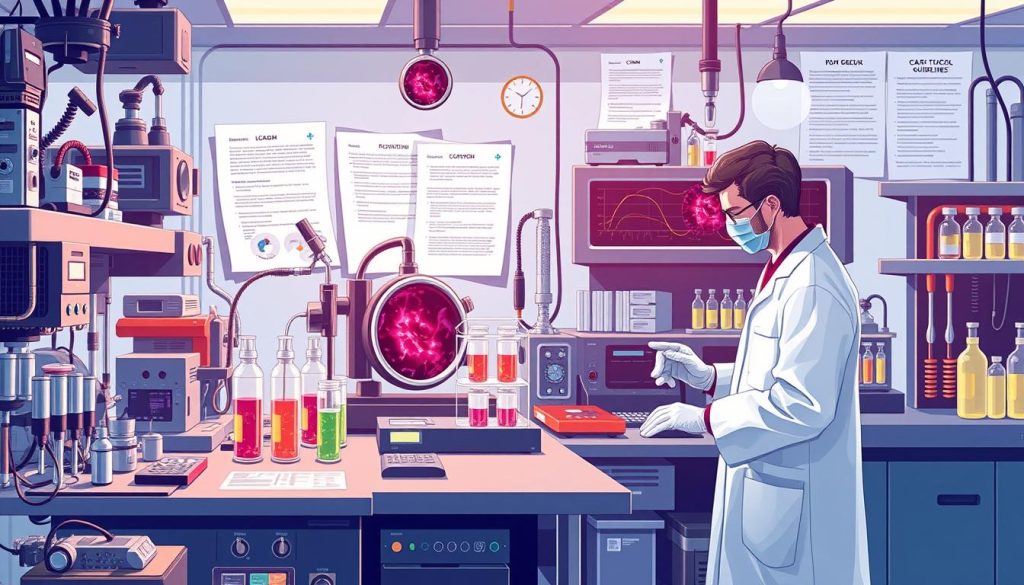
The FDA has a detailed plan for regulating cell and gene therapies, including CAR T cells. This plan covers everything from early studies to ongoing checks after approval. Companies must show all their steps, quality checks, and safety data to meet FDA regulations.
FDA Guidance and Requirements
The FDA has made several guides for CAR T cell therapies. These guides outline what the FDA expects for product development, making, and clinical trials. They talk about things like:
- Chemistry, manufacturing, and control (CMC) requirements
- Preclinical testing and animal studies
- Clinical trial design and endpoints
- Long-term follow-up and safety monitoring
Companies need to follow these guides closely. This helps avoid delays or problems in the approval process.
EMA Regulations and Guidelines
In Europe, the EMA oversees CAR T cell therapies. Like the FDA, the EMA focuses on quality, safety, and effectiveness. EMA guidelines cover many areas, including:
- Quality and manufacturing requirements
- Non-clinical studies and animal models
- Clinical trial design and endpoints
- Risk management and pharmacovigilance
Following EMA rules is critical for companies wanting to sell CAR T cell therapies in Europe.
To get through the regulatory maze, companies need to know the cell therapy regulatory requirements for each market. Working closely with regulatory bodies early on, getting scientific advice, and keeping lines of communication open can make the approval and launch process smoother.
Cost Considerations in CAR T Cell Manufacturing
The making of CAR T cell therapies is complex. It needs special equipment, skilled workers, and top-notch materials. These elements make the cost of these treatments high. It’s key to understand what makes them expensive to find ways to make them cheaper and get them to more patients.
Getting the right raw materials is a big part of the cost. This includes viral vectors, cytokines, and culture media. These items are pricey and can take a long time to get. Managing the supply chain well is important. Also, the special gear needed for making CAR T cells, like bioreactors, is expensive to buy and keep up.
The cost of labor is also a big factor. Making CAR T cells needs experts like scientists and engineers. Training and keeping these skilled workers is hard and adds to the cost.
To tackle these cost issues, people are looking at ways to make the process better and cheaper. Some ideas include:
- Making the process faster to cut down on waste
- Using automation to make things more consistent and save on labor
- Finding better ways to make viral vectors to lower material costs
- Improving cell culture to get more cells and reduce variability
The table below shows how costs can change with better manufacturing:
| Cost Component | Traditional Process | Optimized Process |
|---|---|---|
| Raw Materials | 40-50% | 30-40% |
| Labor | 30-40% | 20-30% |
| Equipment and Facilities | 20-30% | 20-25% |
| Other Costs | 5-10% | 5-10% |
By making the manufacturing process better, costs can go down. This doesn’t mean sacrificing quality or safety. As the field grows, working together and sharing knowledge is key to making these treatments more affordable for everyone.
Closed System Manufacturing for CAR T Cells
As CAR T cell therapies become more popular, manufacturers are using closed system manufacturing. This method uses automated, sealed equipment. It helps reduce contamination risk and improve process control.
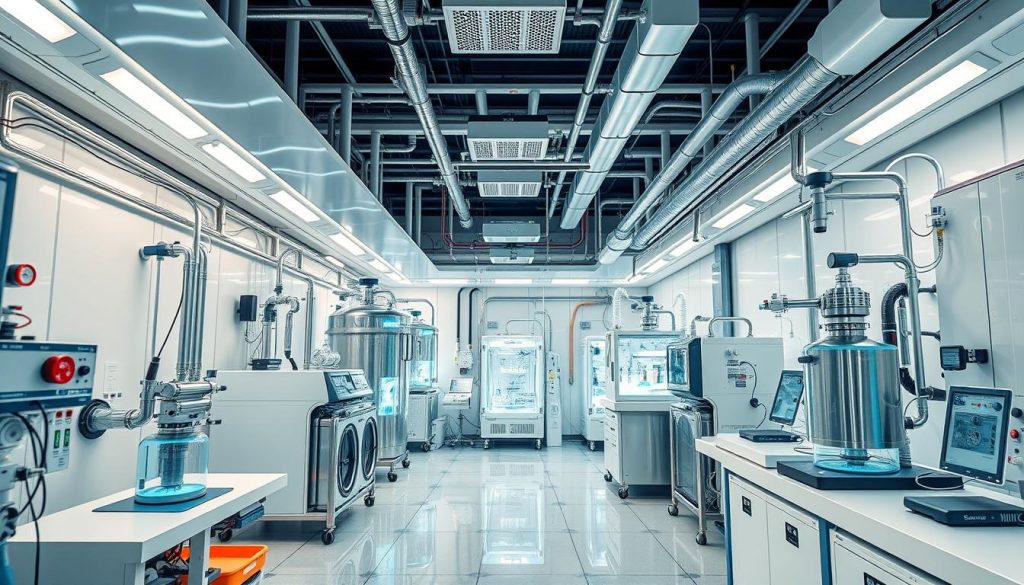
Closed system technologies have big advantages over old methods. They cut down on contamination risk by needing less human touch. This is key for CAR T cells, where keeping things clean is vital for safety and effectiveness.
Advantages of Closed Systems
Closed system manufacturing also means better product quality and efficiency. It offers several benefits:
- Less chance of human mistakes
- More consistent and scalable products
- Easier technology transfer and validation
- Better tracking and data management
Implementing Closed System Technologies
Switching to closed system manufacturing needs careful planning and investment. Manufacturers must look at their current methods and see where they can use closed systems. This might mean:
- Finding the right closed system equipment
- Changing the layout and workflows
- Validating new processes and SOPs
- Training staff on new systems
| Traditional Open Manufacturing | Closed System Manufacturing |
|---|---|
| Higher contamination risk | Reduced contamination risk |
| Manual, operator-dependent processes | Automated, standardized processes |
| Limited process control and reproducibility | Enhanced process control and consistency |
Closed system manufacturing is a big step forward for CAR T cell production. It makes therapies safer, more efficient, and consistent for patients.
As CAR T cell therapy grows, closed system manufacturing will be key. It ensures these treatments are of high quality, safe, and accessible to those who need them.
Future Trends and Innovations in CAR T Cell Manufacturing
Researchers are working hard to make CAR T cell therapies more available and affordable. They aim to improve how these treatments are made. This will help more people get the help they need.
One big step is making off-the-shelf CAR T cell therapies. These don’t need a patient’s own T cells. Instead, they use healthy donor cells. This could make treatments faster and cheaper.
Gene editing, like CRISPR-Cas9, is also changing the game. It lets scientists make T cells that work better and are safer. This could lead to treatments that work for more people.
Using advanced analytics and AI is another big trend. These tools help make CAR T cell production better. They look at lots of data to find ways to improve. This means treatments can be more consistent and of higher quality.
“The future of CAR T cell manufacturing lies in the convergence of cutting-edge technologies and innovative strategies that will make these therapies more accessible, affordable, and effective for patients worldwide.” – Dr. Sarah Thompson, Director of Cell Therapy Research
Here’s a quick look at some of the main trends and innovations in CAR T cell manufacturing:
| Trend/Innovation | Benefits | Challenges |
|---|---|---|
| Allogeneic CAR T cell therapies | Reduced manufacturing time and costs, increased accessibility | Potential for immune rejection, need for precise HLA matching |
| Gene editing technologies | Enhanced potency and safety, creation of universal CAR T cells | Regulatory hurdles, long-term safety concerns |
| Advanced analytics and AI | Process optimization, improved consistency and quality | Data integration and standardization, validation of AI models |
As CAR T cell therapy grows, manufacturers must keep up with new ideas. They need to make sure treatments are safe, work well, and are easy for patients to get.
Conclusion
The making of CAR T cell therapies is a complex process. It involves many steps, from collecting patient cells to the final product. Each step is vital for the therapy’s safety and quality.
Quality control and following rules are key in making CAR T cell therapies. The supply chain also plays a big role. These factors ensure the therapy works well.
As CAR T cell therapy grows, new technologies will be important. Automation and closed systems could make production better and cheaper. This will help meet the demand for these treatments.
The future of CAR T cell therapy looks promising. It could help more than just blood cancers. More research will lead to new uses and improvements.
By working together, we can make more CAR T cell therapies. This will bring hope and healing to many patients. It’s a bright future for this life-saving treatment.
FAQ
Q: What are the key stages in the CAR T cell manufacturing process?
A: The CAR T cell process has several key steps. First, we collect cells through leukapheresis. Then, we activate and modify the T cells genetically. Next, we expand the cells. Lastly, we formulate the final product. Each step is vital for a safe and effective CAR T cell.
Q: Why is quality control so important in CAR T cell manufacturing?
A: Quality control is key to ensure the CAR T cell product’s safety and effectiveness. It involves strict quality systems, testing, and release criteria. These measures help keep the product safe and pure for patients.
Q: What are the challenges associated with scaling up CAR T cell production?
A: Scaling up CAR T cell production faces several hurdles. Maintaining quality, optimizing processes, and increasing capacity are major challenges. Overcoming these is essential to meet growing demand.
Q: How can automation benefit CAR T cell manufacturing?
A: Automation can make CAR T cell production more efficient and consistent. It reduces human error. Yet, it also brings challenges in a highly regulated field. These must be carefully managed.
Q: What role does supply chain management play in CAR T cell therapy production?
A: Supply chain management is vital for CAR T cell therapies. It ensures timely and reliable raw material sourcing and final product distribution. This is critical for maintaining product integrity and viability.
Q: How do regulatory requirements impact CAR T cell manufacturing?
A: CAR T cell manufacturing must comply with strict FDA and EMA regulations. Navigating these regulations is essential for successful product commercialization and compliance.
Q: What are the advantages of closed system manufacturing for CAR T cells?
A: Closed system manufacturing offers several benefits for CAR T cell production. It reduces contamination risk and improves process control. This technology can enhance product quality and safety.
Q: What does the future hold for CAR T cell manufacturing?
A: The future of CAR T cell manufacturing looks promising. It may include off-the-shelf therapies and gene editing technologies. Advanced analytics and artificial intelligence could also optimize production. These advancements could make CAR T cell therapy more accessible to patients.











